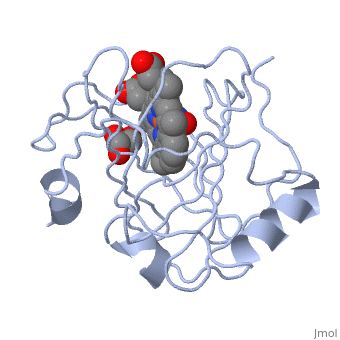4xme
From Proteopedia
Crystal structure of nitrophorin 7 from Rhodnius prolixus at pH 7.8 complexed with NO
Structural highlights
FunctionNP7_RHOPR Converts nitrite as the sole substrate to form nitric oxide gas (NO). NO(2-) serves both as an electron donor and as an electron acceptor. Binds to negatively charged cell surfaces of activated platelets; binds to L-a-phosphatidyl-L-serine (PS)-bearing phospholipid membranes. Once bound on an activated platelet, NP7 releases its stored nitric oxide gas (NO) into the victim's tissues while feeding, resulting in vasodilation and inhibition of platelet aggregation. Also acts as an anticoagulant by blocking coagulation-factor binding sites. Has antihistamine activity; binds histamine with high affinity.[1] [2] [3] [4] [5] Publication Abstract from PubMedNitrophorins represent a unique class of heme proteins that are able to perform the delicate transportation and release of the free-radical gaseous messenger nitric oxide (NO) in a pH-triggered manner. Besides its ability to bind to phospholipid membranes, the N-terminus contains an additional Leu-Pro-Gly stretch, which is a unique sequence trait, and the heme cavity is significantly altered with respect to other nitrophorins. These distinctive features encouraged us to solve the X-ray crystallographic structures of NP7 at low and high pH and bound with different heme ligands (nitric oxide, histamine, imidazole). The overall fold of the lipocalin motif is well preserved in the different X-ray structures and resembles the fold of other nitrophorins. However, a chain-like arrangement in the crystal lattice due to a number of head-to-tail electrostatic stabilizing interactions is found in NP7. Furthermore, the X-ray structures also reveal ligand-dependent changes in the orientation of the heme, as well as in specific interactions between the A-B and G-H loops, which are considered to be relevant for the biological function of nitrophorins. Fast and ultrafast laser triggered ligand rebinding experiments demonstrate the pH-dependent ligand migration within the cavities and the exit route. Finally, the topological distribution of pockets located around the heme as well as from inner cavities present at the rear of the protein provides a distinctive feature in NP7, so that while a loop gated exit mechanism to the solvent has been proposed for most nitrophorins, a more complex mechanism that involves several interconnected gas hosting cavities is proposed for NP7. Structure and dynamics of the membrane attaching nitric oxide transporter nitrophorin 7.,Knipp M, Ogata H, Soavi G, Cerullo G, Allegri A, Abbruzzetti S, Bruno S, Viappiani C, Bidon-Chanal A, Luque FJ F1000Res. 2015 Feb 13;4:45. doi: 10.12688/f1000research.6060.1. eCollection 2015. PMID:26167269[6] From MEDLINE®/PubMed®, a database of the U.S. National Library of Medicine. See AlsoReferences
| ||||||||||||||||||||

